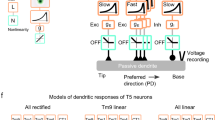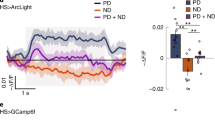Abstract
The perception of motion is an important function of vision. Neural wiring diagrams for extracting directional information have been obtained by connectome reconstruction. Direction selectivity in Drosophila is thought to originate in T4/T5 neurons through integrating inputs with different temporal filtering properties. Through genetic screening based on synaptic distribution, we isolated a new type of TmY neuron, termed TmY-ds, that form reciprocal synaptic connections with T4/T5 neurons. Its neurites responded to grating motion along the four cardinal directions and showed a variety of direction selectivity. Intriguingly, its direction selectivity originated from temporal filtering neurons rather than T4/T5. Genetic silencing and activation experiments showed that TmY-ds neurons are functionally upstream of T4/T5. Our results suggest that direction selectivity is generated in a tripartite circuit formed among these three neurons—temporal filtering, TmY-ds, and T4/T5 neurons, in which TmY-ds plays a role in the enhancement of direction selectivity in T4/T5 neurons.






Similar content being viewed by others
References
Borst A, Helmstaedter M. Common circuit design in fly and mammalian motion vision. Nat Neurosci 2015, 18: 1067–1076.
Helmstaedter M, Briggman KL, Turaga SC, Jain V, Seung HS, Denk W. Connectomic reconstruction of the inner plexiform layer in the mouse retina. Nature 2013, 500: 168–174.
Takemura SY, Bharioke A, Lu Z, Nern A, Vitaladevuni S, Rivlin PK. A visual motion detection circuit suggested by Drosophila connectomics. Nature 2013, 500: 175–181.
Mauss AS, Vlasits A, Borst A, Feller M. Visual circuits for direction selectivity. Annu Rev Neurosci 2017, 40: 211–230.
Fischbach KF, Dittrich APM. The optic lobe of Drosophila melanogaster. I. A Golgi analysis of wild-type structure. Cell Tissue Res 1989, 258: 441–475.
Shinomiya K, Huang G, Lu Z, Parag T, Xu CS, Aniceto R, et al. Comparisons between the ON- and OFF-edge motion pathways in the Drosophila brain. Elife 2019, 8: e40025.
Bahl A, Ammer G, Schilling T, Borst A. Object tracking in motion-blind flies. Nat Neurosci 2013, 16: 730–738.
Mauss AS, Meier M, Serbe E, Borst A. Optogenetic and pharmacologic dissection of feedforward inhibition in Drosophila motion vision. J Neurosci 2014, 34: 2254–2263.
Schnell B, Raghu SV, Nern A, Borst A. Columnar cells necessary for motion responses of wide-field visual interneurons in Drosophila. J Comp Physiol A Neuroethol Sens Neural Behav Physiol 2012, 198: 389–395.
Maisak MS, Haag J, Ammer G, Serbe E, Meier M, Leonhardt A, et al. A directional tuning map of Drosophila elementary motion detectors. Nature 2013, 500: 212–216.
Fisher YE, Silies M, Clandinin TR. Orientation selectivity sharpens motion detection in Drosophila. Neuron 2015, 88: 390–402.
Meier M, Borst A. Extreme compartmentalization in a Drosophila amacrine cell. Curr Biol 2019, 29: 1545–1550.
Serbe E, Meier M, Leonhardt A, Borst A. Comprehensive characterization of the major presynaptic elements to the Drosophila OFF motion detector. Neuron 2016, 89: 829–841.
Strother JA, Wu ST, Wong AM, Nern A, Rogers EM, Le JQ, et al. The emergence of directional selectivity in the visual motion pathway of Drosophila. Neuron 2017, 94: 168–182.
Arenz A, Drews MS, Richter FG, Ammer G, Borst A. The temporal tuning of the Drosophila motion detectors is determined by the dynamics of their input elements. Curr Biol 2017, 27: 929–944.
Behnia R, Clark DA, Carter AG, Clandinin TR, Desplan C. Processing properties of ON and OFF pathways for Drosophila motion detection. Nature 2014, 512: 427–430.
Yang HH, St-Pierre F, Sun X, Ding X, Lin MZ, Clandinin TR. Subcellular imaging of voltage and calcium signals reveals neural processing in vivo. Cell 2016, 166: 245–257.
Takemura SY, Nern A, Chklovskii DB, Scheffer LK, Rubin GM, Meinertzhagen IA. The comprehensive connectome of a neural substrate for ‘ON’ motion detection in Drosophila. Elife 2017, 6: e24394.
Han C, Wang D, Soba P, Zhu S, Lin X, Jan LY, et al. Integrins regulate repulsion-mediated dendritic patterning of Drosophila sensory neurons by restricting dendrites in a 2D space. Neuron 2012, 73: 64–78.
Zhang Y, Guo H, Kwan H, Wang JW, Kosek J, Lu B. PAR-1 kinase phosphorylates Dlg and regulates its postsynaptic targeting at the Drosophila neuromuscular junction. Neuron 2007, 53: 201–215.
Feinberg EH, Vanhoven MK, Bendesky A, Wang G, Fetter RD, Shen K, et al. GFP Reconstitution Across Synaptic Partners (GRASP) defines cell contacts and synapses in living nervous systems. Neuron 2008, 57: 353–363.
Brand AH, Perrimon N. Targeted gene expression as a means of altering cell fates and generating dominant phenotypes. Development 1993, 118: 401–415.
Lai SL, Lee T. Genetic mosaic with dual binary transcriptional systems in Drosophila. Nat Neurosci 2006, 9: 703–709.
Gordon MD, Scott K. Motor control in a Drosophila taste circuit. Neuron 2009, 61: 373–384.
Yue YL, Ke SS, Zhou W, Chang J. In vivo imaging reveals composite coding for diagonal motion in the Drosophila visual system. PLoS One 2016, 11: e0164020.
Zheng T, Yang Z, Li A, Lv X, Zhou Z, Wang X, et al. Visualization of brain circuits using two-photon fluorescence micro-optical sectioning tomography. Opt Express 2013, 21: 9839–9850.
Xia S, Xu HT. Astrocytic gap junctions contribute to aberrant neuronal synchronization in a mouse model of MeCP2 duplication syndrome. Neurosci Bull 2022, 38: 591–606.
Reiser MB, Dickinson MH. A modular display system for insect behavioral neuroscience. J Neurosci Methods 2008, 167: 127–139.
Li B, Li S, Yan Z. Axonemal dynein DNAH5 is required for sound sensation in Drosophila larvae. Neurosci Bull 2021, 37: 523–534.
Yu Q, Fu H, Wang G, Zhang J, Yan B. Short-term visual experience leads to potentiation of spontaneous activity in mouse superior colliculus. Neurosci Bull 2021, 37: 353–368.
Kim J, Zhao T, Petralia RS, Yu Y, Peng H, Myers E, et al. mGRASP enables mapping mammalian synaptic connectivity with light microscopy. Nat Methods 2011, 9: 96–102.
Jenett A, Rubin GM, Ngo TT, Shepherd D, Murphy C, Dionne H, et al. A Gal4-driver line resource for Drosophila neurobiology. Cell Rep 2012, 2: 991–1001.
Baines RA, Uhler JP, Thompson A, Sweeney ST, Bate M. Altered electrical properties in Drosophila neurons developing without synaptic transmission. J Neurosci 2001, 21: 1523–1531.
Klapoetke NC, Murata Y, Kim SS, Pulver SR, Birdsey-Benson A, Cho YK, et al. Independent optical excitation of distinct neural populations. Nat Methods 2014, 11: 338–346.
Joesch M, Schnell B, Raghu SV, Reiff DF, Borst A. ON and OFF pathways in Drosophila motion vision. Nature 2010, 468: 300–304.
Clark DA, Bursztyn L, Horowitz MA, Schnitzer MJ, Clandinin TR. Defining the computational structure of the motion detector in Drosophila. Neuron 2011, 70: 1165–1177.
Fisher YE, Leong JC, Sporar K, Ketkar MD, Gohl DM, Clandinin TR, et al. A class of visual neurons with wide-field properties is required for local motion detection. Curr Biol 2015, 25: 3178–3189.
Ding H, Smith RG, Poleg-Polsky A, Diamond JS, Briggman KL. Species-specific wiring for direction selectivity in the mammalian retina. Nature 2016, 535: 105–110.
Matsumoto A, Agbariah W, Nolte SS, Andrawos R, Levi H, Sabbah S, et al. Direction selectivity in retinal bipolar cell axon terminals. Neuron 2021, 109: 2928–2942.
Shinomiya K, Nern A, Meinertzhagen IA, Plaza SM, Reiser MB. Neuronal circuits integrating visual motion information in Drosophila melanogaster. Curr Biol 2022, 32: 3529–3544.
Jagadish S, Barnea G, Clandinin TR, Axel R. Identifying functional connections of the inner photoreceptors in Drosophila using Tango-Trace. Neuron 2014, 83: 630–644.
Guo C, Pan Y, Gong Z. Recent advances in the genetic dissection of neural circuits in Drosophila. Neurosci Bull 2019, 35: 1058–1072.
Wang J, Zhao W, Zhao Q, Zhou J, Li X, He Y, et al. Drosophila larval light-avoidance is negatively regulated by temperature through two pairs of central brain neurons. Neurosci Bull 2022, 38: 200–204.
Shearin HK, Quinn CD, Mackin RD, Macdonald IS, Stowers RS. t-GRASP, a targeted GRASP for assessing neuronal connectivity. J Neurosci Methods 2018, 306: 94–102.
Ji X, Yuan D, Wei H, Cheng Y, Wang X, Yang J, et al. Differentiation of Theta visual motion from Fourier motion requires LC16 and R18C12 neurons in Drosophila. iScience 2020, 23: 101041.
Acknowledgements
We thank Dr. Yufeng Pan (University of Southeast, China) and the Bloomington Drosophila Stock Center (NIH P40OD018537) for sharing stocks in this study. We thank Dr. Chi-hon Lee (Academia Sinica, Taipei, China) and CBMP-HUST colleagues, as well as the three anonymous reviewers for their constructive comments and suggestions. We also thank the Optical Bioimaging Core Facility of WNLO-HUST for imaging systems. This work was supported by grants from the National Natural Science Foundation of China (61890950 and 31871027), Fundamental Research Funds for the Central Universities/HUST (2016YXMS034 and 2014TS015), the Director Fund of WNLO, and the China Postdoctoral Science Foundation (2015T80788).
Author information
Authors and Affiliations
Corresponding authors
Ethics declarations
Conflict of interest
The authors declare no competing interests concerning the subject of this study.
Supplementary Information
Below is the link to the electronic supplementary material.
Rights and permissions
Springer Nature or its licensor (e.g. a society or other partner) holds exclusive rights to this article under a publishing agreement with the author(s) or other rightsholder(s); author self-archiving of the accepted manuscript version of this article is solely governed by the terms of such publishing agreement and applicable law.
About this article
Cite this article
Zhao, Y., Ke, S., Cheng, G. et al. Direction Selectivity of TmY Neurites in Drosophila. Neurosci. Bull. 39, 759–773 (2023). https://doi.org/10.1007/s12264-022-00966-y
Received:
Accepted:
Published:
Issue Date:
DOI: https://doi.org/10.1007/s12264-022-00966-y




